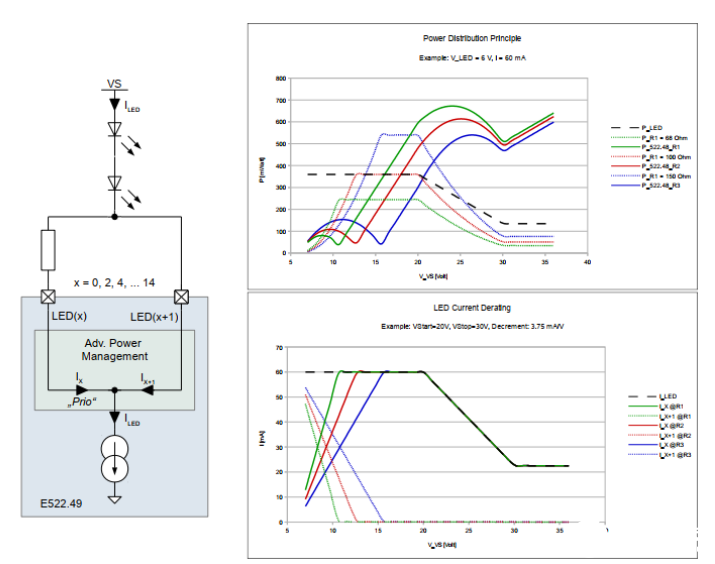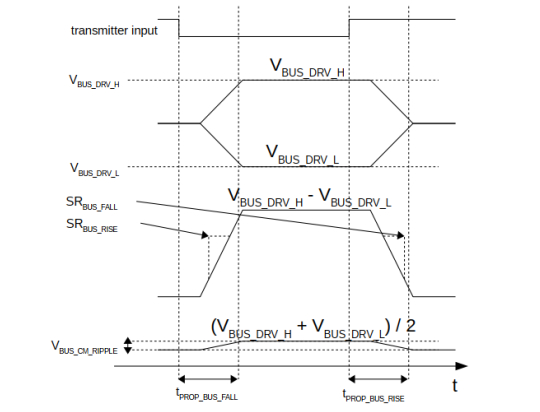The new favorite of car lights—E522.49
With the development of technology, automotive LED lighting quickly occupied the market with the incomparable advantages of halogen lamps. At the same time, traditional lamp drivers are no longer suitable for the needs of diversified effects. Therefore, ELMOS has brought the latest E522.49 to solve the industry’s pain points.
With the advancement of technology, the rear lighting system of automobiles has been greatly developed in order to meet the needs of the market for the functions and individualization of the taillights. This has led to a more complex LED drive system. The existing lamp drive chips are not suitable for the current electronic and electrical systems. For this reason, ELMOS, which has been focusing on the automotive market for 30 years, has launched the E522.49 chip that meets the new market needs:
1. E522.49 chip structure and characteristics

- Fast differential bus interface for dynamic LED control
Device and LED power supply voltage range from 5V to 40V
16 PWM generators with 10-bit resolution
16 programmable LED drivers, maximum current 100mA
Direct PWM input
10-bit ADC for LED open circuit, short circuit and system diagnosis
Functional safety ASIL-B level
2. Can E522.49 solve the difficulties of taillight design?
1. Thermal Management

Automotive lamp circuits need to work at ambient temperatures up to 85°C. This maximum temperature includes the temperature increase in the housing caused by self-heating in the enclosed lamp. The high ambient temperature presents two challenges to the LED rear light: controlling the junction temperature of the LED and the LED driver. However, since the package size of the LED and the driver is constant, the heat dissipation power of the chip is also constant, so thermal management becomes very important.
In order to solve the thermal management problem, E522.49 can adopt the circuit in the above figure, and distribute the power consumption proportionally to the heat dissipation resistance of the even-numbered channels to avoid local hot spots on the PCB. In this unique solution, part of the power consumption is dissipated by the chip itself, and the other part is dissipated by external devices. Compared with traditional lamp drivers, it can bring more design margins to customers and solve the problem of heat distribution.
- EMI compatibility

Although most existing rear lights use microcontroller universal input/output or simple interfaces (such as I2C), these simple interface architectures may not meet the needs of larger rear lights when the light design covers the entire rear of the car . The communication interfaces in these systems must comply with EMC standards without introducing communication errors. However, it is well known that the I2C bus has strict timing requirements and will cause serious EMC problems. Especially today, the use of traditional serial communication is clearly not in line with the needs of the market when new energy vehicles are popularized.
In order to solve this problem, E522.49 uses the industry’s common CAN physical layer, and the flexible wire interface based on UART can easily realize long-distance inter-board communication, improving performance without affecting EMC performance.
- Animation trends
The animation in the rear light can realize flexible style and personalization (such as welcome message). The new design uses complex animations, and the rear light design is shifting from controlling LED strings to independently driving individual LED pixels. And this function can only be completed by using a single device. The 16 channels of E522.49 can easily realize the transition from LED string control to independent pixel control.
- Fault diagnosis
Car lights must meet the requirements of their lighting output regulations during their service life. Although the life expectancy of LEDs is much longer than the maximum operating time of the vehicle, LEDs are still susceptible to random failures. Up to 80% of random LED faults are open circuit faults, and less than 20% are short circuit faults. Although it is relatively simple to detect an LED open circuit in a single string of LEDs, it may not be so easy to detect a single LED short circuit. E522.49 has a 16-channel ADC inside, which can easily realize single-lamp level open-circuit and short-circuit fault detection.
- Functional safety
Generally speaking, the safety requirement level of car lamp products is ASILB. There are almost no lamp driver chips supporting functional safety on the market. The development of ELMOSE522.49 is based on the ISO26262 process that has passed ISO certification.

